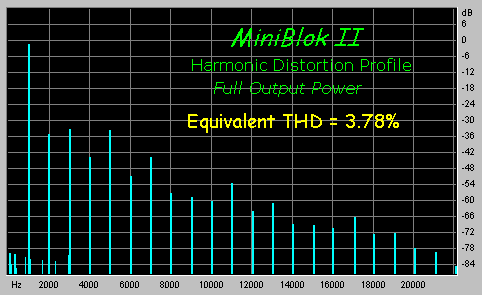
Time-domain graph at full output (3.5w), 8 ohms
|
Part 1: Introduction |
Part 2: How It Works |
Part 3: Performance |
Part 4: Construction |
Part 5: Parts List |
Part 6: Sound Sample |
| PARAMETER | LOW (42:1) TAP | HIGH (28:1) TAP |
| Max. Output power (8 ohms) | 2.3 watts | 3.5 watts |
| Max. Output power (4 ohms) | 3.0 watts | 3.4 watts |
| Effective Output Resistance | 2.6 ohms | 6.2 ohms |
| PARAMETER | SPECIFICATION | NOTES |
| Input Resistance | 100 kilohm | determined by volume control R6 |
| Input Sensitivity | 0.55 volts RMS | min. input signal for full output |
| Low Frequency Response | -3 dB @ 32 Hz. | (-6 dB @ 22 Hz.) |
| High Frequency Response | -3 dB @ 10.5 kHz. | (-6 dB at 16 kHz.) |
| Maximum THD | 3.78% | calculated at full output |
| Typical THD | 1.65% | calculated at 1/2-voltage point |
| Hum and Noise | ~ -80 dB | relative to maximum output |


 |
 |
 |
BACK | HOME | NEXT |